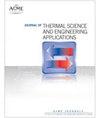Enhancing Gas Turbine Power Plant Performance in Tropical Climates by Using Inlet Air Cooling with Desiccant Dehumidification and Evaporative Cooling
IF 1.4
4区 工程技术
Q3 ENGINEERING, MECHANICAL
引用次数: 0
Abstract
Abstract Gas turbine power plants play a crucial role in meeting the growing demand for electrical energy. However, their performance can be hindered by high ambient temperatures and humidity levels in tropical climates, leading to a drop in power output. This study investigates the potential benefits of using inlet air cooling with desiccant dehumidification and evaporative cooling to improve the performance of gas turbine power plants in tropical regions. The results show that this inlet air cooling method, integrating evaporative cooling, desiccant wheel, and Maisotsenko cooler, is a viable alternative for mitigating the performance decrease of gas turbines in hot tropical conditions. Furthermore, the compressor inlet temperature can be reduced on average by 11.5 °C by using turbine exhaust gases to heat the regeneration air utilized in the desiccant wheel for dehumidification. Additionally, the power requirement of the inlet air cooling system amounts to around 0.9 MW compared with an improvement of more than 2 MW in power output at peak temperature. Further research is needed to understand and quantify other benefits related to inlet air cooling, such as reducing emissions of harmful pollutants and operating at higher turbine inlet temperatures.采用进气冷却、干燥剂除湿和蒸发冷却提高热带气候下燃气轮机电厂性能
摘要燃气轮机发电厂在满足日益增长的电力需求方面发挥着至关重要的作用。然而,它们的性能可能会受到热带气候中高环境温度和高湿度水平的阻碍,从而导致功率输出下降。本研究探讨了在热带地区采用进气冷却结合干燥剂除湿和蒸发冷却来改善燃气轮机电厂性能的潜在效益。结果表明,这种将蒸发冷却、干燥剂轮和Maisotsenko冷却器集成在一起的进气冷却方法是缓解炎热热带条件下燃气轮机性能下降的可行替代方案。此外,利用涡轮废气加热干燥剂轮中用于除湿的再生空气,可使压气机进口温度平均降低11.5℃。此外,进气冷却系统的功率需求约为0.9 MW,而峰值温度下的功率输出则提高了2 MW以上。需要进一步的研究来了解和量化与进口空气冷却相关的其他好处,例如减少有害污染物的排放和在更高的涡轮进口温度下运行。
本文章由计算机程序翻译,如有差异,请以英文原文为准。
求助全文
约1分钟内获得全文
求助全文
来源期刊

Journal of Thermal Science and Engineering Applications
THERMODYNAMICSENGINEERING, MECHANICAL -ENGINEERING, MECHANICAL
CiteScore
3.60
自引率
9.50%
发文量
120
期刊介绍:
Applications in: Aerospace systems; Gas turbines; Biotechnology; Defense systems; Electronic and photonic equipment; Energy systems; Manufacturing; Refrigeration and air conditioning; Homeland security systems; Micro- and nanoscale devices; Petrochemical processing; Medical systems; Energy efficiency; Sustainability; Solar systems; Combustion systems
 求助内容:
求助内容: 应助结果提醒方式:
应助结果提醒方式:


